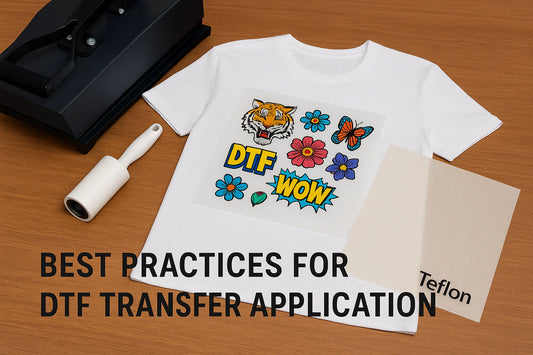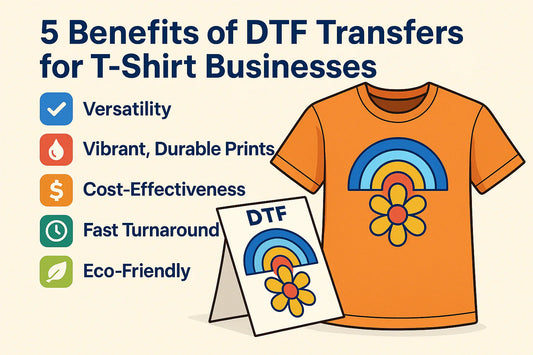Excellent print made t-shirts for some teachers.

5 Essential Tips for Creating High-Quality DTF Designs in Canva
Why Use Canva for DTF Designs?
If you're a t-shirt business owner, Etsy seller, or a small apparel brand diving into Direct-to-Film (DTF) printing, you may be asking yourself: Can I create professional, retail-quality DTF designs in Canva? The answer is a confident yes.
Canva Pro unlocks a world of graphics, fonts, and user-friendly design tools that are perfect for beginners and experienced designers alike. In this guide, you’ll learn five key tips for using Canva to produce vibrant, high-quality DTF designs that wow your customers and keep your prints looking sharp.
Tip 1: Set the Right Resolution for Perfect Prints
For DTF transfers, image quality makes all the difference. Most DTF printers and services require designs at 300 DPI (dots per inch) for crisp, professional results. However, Canva does not allow you to set DPI directly. No worries—there’s a solid workaround: design by pixel dimensions.
How to Calculate Pixel Dimensions in Canva
- Decide the final size you want your print. For example, a 12-inch by 10-inch graphic.
- Multiply each dimension in inches by 300 to convert to pixels:
- Width: 12 x 300 = 3600 pixels
- Height: 10 x 300 = 3000 pixels
When starting your Canva project, set the units to pixels and enter these values. This ensures your exported PNG will be the right print quality, giving your DTF designs in Canva a professional edge.
Tip 2: Use the Best Design Elements for DTF Success
DTF printing is amazing for translating bold, colorful designs onto garments. Canva’s vast selection of images, icons, and fonts gives you endless options, but to maximize results you should design to the strengths of DTF:
- Stick to fully opaque graphics—DTF doesn’t handle transparency (like glows or soft shadows) well.
- Choose bold, simple fonts for small text and avoid ultra-thin lines.
- Avoid very tiny design elements such as splatters, tiny stars, or hairline strokes that might not print cleanly.
- When possible, break up large solid color areas to minimize heavy ink coverage.
Think clean, readable, and vibrant. Keeping these design best practices in mind helps your Canva artwork print sharply on DTF transfers.
Tip 3: Preview Your Design Against Garment Colors
DTF prints every color—including white. Accidentally leaving white areas in your design could result in unwanted patches on your garment. A smart trick is to change your Canva background to either a neutral gray or, even better, the actual garment color you’ll be printing on.
- Set your Canva background to the shirt color.
- Look for hidden white areas, halos, or weak color contrast.
- Adjust your design colors as needed for better harmony between artwork and apparel.
This simple step can be the difference between “okay” prints and truly retail-quality DTF designs.
Tip 4: Perform a Thorough Design Check Before Exporting
Before sending your art to print, always give it a final review. Check for spelling errors, misplaced elements, and font consistency. A useful trick is to toggle your background color—this can make hidden issues pop out so you can fix them before exporting.
- Check all text for spelling, grammar, and readability.
- Zoom in closely to review small details and make sure there are no stray elements.
- Switch background colors to catch unwanted artifacts or off-white areas that could accidentally print.
Spending a few extra minutes here can save time, money, and frustration by avoiding misprints.
Tip 5: Export Your Canva DTF Design in the Correct Format
Now you’re ready to export! For most DTF printers, a high-resolution PNG is recommended. If you’ve set up your design with proper pixel dimensions, simply click Share, choose PNG, and download. If you need to resize at export, use the size slider and enter your target pixel values (width and height) as previously calculated. Make sure both dimensions match your 300 DPI math.
- Click Share → Download → PNG.
- Sse the size slider so it matches your target pixel size
(for example, 3600 × 3000 px for a 12 × 10 inch design). - Download the file and double-check the pixel dimensions before sending it to your DTF printer or supplier.
Once you have your DTF design exported from Canva, upload it to your printer software or submit to a service such as Heat Press Nation’s True Print. They’ll handle the rest—delivering retail-quality transfers ready for pressing!
Conclusion: Start Creating Stunning DTF Designs in Canva Today
Armed with these essential tips, you’re ready to create vibrant, professional DTF designs in Canva—no advanced design software required. Remember to:
- Work at the correct effective resolution
- Use bold, simple design elements
- Preview on realistic garment colors
- Do a careful pre-print review
- Export your artwork in the right format
Ready to turn your ideas into eye-catching apparel? Try these techniques on your next batch of DTF transfers.
If you need pro-quality DTF transfer printing, you can upload your Canva designs to Sam’s DTF Transfers for fast turnaround, vibrant prints, and reliable results on every order.
No comments












0 comments